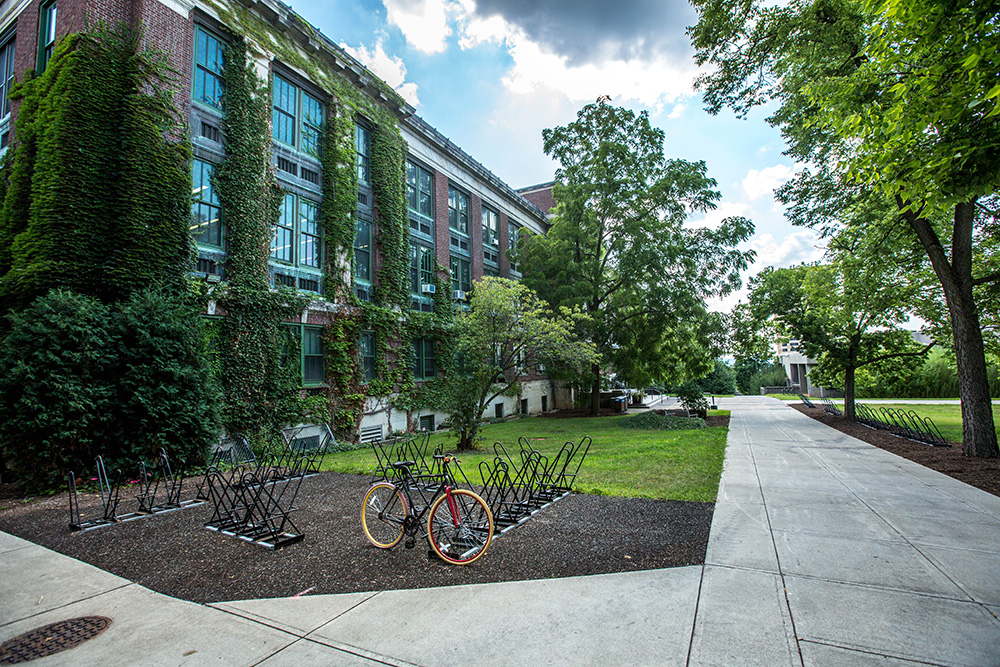Tilly Lockey was diagnosed with Meningococcal Septicaemia Strain B when she was 15 months old. Due to that disease, the doctors had to amputate both her arms and toes to give her a chance to survive. Since then, her mom has been fighting to ensure that she can do everything that children with hands can do. In the past years, they tried various myoelectric prosthesis, which Tilly describes as “very basic” as these were only capable of opening and closing. In January 2019 Tilly was surprised with Open Bionic Hero Arms for the Alita: Battle Angel film premiere. This medically certified prosthesis is custom 3D-printed and detects muscle movement thanks to special sensors. It works fully intuitively and provides its user with feedback through vibrations, lights and sounds. Thanks to 3D printing, an arm can be made within 40 hours and is quite affordable compared to other bionic hands (launching price of £5,000). The Hero Arms allow Tilly to be a “normal” teenager. She says she feels “more like everyone else”. Which is apparent in simple things such as doing thumbs up on a selfie or playing the Wii. Intelligent prostheses like the Hero Arms have a great impact on the quality of life for people like Tilly. It is that kind of transhuman achievements that increase independence and self-confidence tremendously for individuals. Here you can find more Hero Arm success stories (image source: Open Bionics Press Images).
An Autonomous Ship at Sea
The Mayflower Autonomous Ship (MAS) could be the first vessel to cross the Atlantic that is able to navigate around obstacles and hazards by itself. It will depart from Plymouth, UK on the fourth centenary of the original Mayflower voyage, on 6 September 2020, and will reach Plymouth, USA after an ecxiting tour, dedicated to science. “The project was put together by marine research and exploration company ProMare in an effort to expand the scope of marine research. The boat will carry three research pods equipped with scientific instruments to measure various phenomena such as ocean plastics, mammal behaviour or sea level changes.” (ZDnet, 16 October 2019) According to ZDnet, IBM has now joined the initiative to supply technical support for all navigation operations. It is important that the futuristic ship is not only careful with things, but also with animals. In this context, insights of animal-machine interaction and machine ethics might be useful. Ultimately, the excursion will help the marine mammals by obtaining data on their behaviour.
Towards Robots with Artificial Skin
“Sensitive synthetic skin enables robots to sense their own bodies and surroundings – a crucial capability if they are to be in close contact with people. Inspired by human skin, a team at the Technical University of Munich (TUM) has developed a system combining artificial skin with control algorithms and used it to create the first autonomous humanoid robot with full-body artificial skin.” (Press Release TUM, 10 October 2019) The robot skin consists of hexagonal cells which are about the size of a two-euro coin. Each of them is equipped with a microprocessor and sensors to detect contact, acceleration, proximity, and temperature. “Such artificial skin enables robots to perceive their surroundings in much greater detail and with more sensitivity. This not only helps them to move safely. It also makes them safer when operating near people and gives them the ability to anticipate and actively avoid accidents.” (Press Release TUM, 10 October 2019) The artificial skin could become important for service robots of all kinds, but also for certain industrial robots (Photo: Department of Electrical and Computer Engineering, Astrid Eckert).
Atlas Does a Handstand
In a new video, Boston Dynamics shows its humanoid Atlas performing various gymnastics exercises. This was reported by Heise on 26 September 2019 with reference to various sources. The well-known robot is 1.50 meters high and weighs 80 kilograms. It has two legs and two arms and the impression of a head. Among other things, it does a handstand and several somersaults, and it jumps with rotation around its own axis. Obviously, it can do complex physical movements typically only possible for humans. According to Heise, a new optimization algorithm, which translates certain maneuvers into executable reference movements, enables this progress in movements. Boston Dynamics is part of SoftBank. The Japanese company also manufactures Pepper and Nao, the well-known robots of the formerly independent French company Aldebaran Robotics.
Robots for Climate
On 20 September 2019 FridaysforFuture had called for worldwide climate strikes. Hundreds of thousands of people around the world took to the streets to protest for more sustainable industry and long-term climate policies to combat global warming. Technological progress and the protection of the environment do not necessarily have to contradict. Quite the opposite, we will present 3 robots which show that technology can be used to achieve climate goals. Planting trees is the most efficient strategy to recover biodiversity and stop climate change. However, this method requires lots of human power. The GrowBot automates this task resulting in a planting rate that is 10 times faster than trained human planters. Unique from planting drones, this small truck-like robot not only spreads seeds, but it plants small trees into the soil, giving them a better chance to survive and foster reforestation. The bio-inspired Row-bot converts organic matter into operating power just as the water boatman (a bug). The robot’s engine is based on a microbial fuel cell (MFC) which enables the robot to swim. Researchers from the Bristol Robotics Laboratory developed the 3D-printed Row-bot for environmental clean-up operations such as harmful algal bloom, oil spills or monitoring the impact of (natural or man-made) environmental catastrophes. Next-level-recycling like in the movie WALL·E can be expected with the sorting robot RoCycle which is developed at MIT. Other than classic recycling machines the robot is capable of distinguishing paper, plastic and metal carbage by using pressure sensors. This tactile solution is 85% accurate at detecting in stationary use and 63% when attached to an assembly line. Through cameras and magnets, the researchers aim to optimise recycling to help cleaning Earth.
Talk to the Shuttle
Olli 2.0 is born. Local Motors and IBM had presented an autonomous shuttle in 2016 that reminded of the Smart Shuttle operated by PostAuto AG in Sion, Valais. Unlike this one, however, Olli 1.0 could not only think but also speak, both at a high level and with the help of IBM Watson. Passengers’ wishes are accepted, for example with regard to destinations, and these are even suggested; when it is hot, the car drives to the nearest ice cream parlour. Olli could also reassure passengers or passers-by: “For citizens of Maryland, many of whom have never seen a self-driving car, Watson’s reassuring communications could be critical to making them more comfortable with the idea that there’s no human being at the wheel.” (Information IBM) Olli 2.0, launched in 2019, can not only access IBM Watson, but also Amazon’s deep learning chatbot service Lex. Something else is different from the predecessor: Olli is now 80% 3D-printed. This was reported by Techcrunch on August 31, 2019. The magazine contains more interesting information about the shuttle. By the way, it is intended for small areas, especially for trade fairs and university campuses. But like the Smart Shuttle, it has already been tested in small cities.
An Exosuit for Walking and Running
“Walking and running require different gaits, with each type of motion putting a greater bias on different muscles and joints.” (Science 2019) Exoskeletons can support people in many ways. However, it is not easy for them to adjust to different types of motion. Jinsoo Kim and his co-authors discuss a possible solution in their article “Reducing the metabolic rate of walking and running with a versatile, portable exosuit”, published in the current issue of Science (16 August 2019). “They developed a soft, fully portable, lightweight exosuit that is able to reduce the metabolic rate for both running and walking by assisting each motion via the hip extension … A waist belt holds most of the mass, thus reducing the cost of carrying the suit. By tracking the motion of the user, the suit is able to switch modes between the two types of motion automatically.“ (Science 2019) There are many possible applications for the exosuit, both civil and military. The article can be downloaded here.
The Bartender Robot
The activities in a pub or a club are demanding. You have to take orders from guests, you have to understand them and be friendly to them, and you have to prepare drinks like Porn Star Martini or White Lady behind the counter. Then you must bring the bill, take money and give change. Robots are more or less good at these things. F&P Robotics has developed Barney, a complete and simple robotic bar solution. The Swiss company is known for its ambitious robots for therapy and care. Now it obviously wants to conquer the gastronomy. Barney offers an easy-to-use interface and a simple payment system. According to the manufacturer, the system impresses with elegant movements during the preparation of the drink. As a typical cobot, it can also work hand in hand with human bartenders. At Hotel Interlaken, Switzerland, you can see Barney in action from 13 August to 15 September 2019. You can form your own opinion and either come to the conclusion that this is the future – or that you still want a human service and a human smile. More information via www.barney-bar.com.
About Basic Property
The title of one of the AAAI 2019 Spring Symposia was “Interpretable AI for Well-Being: Understanding Cognitive Bias and Social Embeddedness”. An important keyword here is “social embeddedness”. Social embeddedness of AI includes issues like “AI and future economics (such as basic income, impact of AI on GDP)” or “well-being society (such as happiness of citizen, life quality)”. In his paper “Are Robot Tax, Basic Income or Basic Property Solutions to the Social Problems of Automation?”, Oliver Bendel discusses and criticizes these approaches in the context of automation and digitization. Moreover, he develops a relatively unknown proposal, unconditional basic property, and presents its potentials as well as its risks. The lecture by Oliver Bendel took place on 26 March 2019 at Stanford University and led to lively discussions. It was nominated for the “best presentation”. The paper has now been published as a preprint and can be downloaded here.
No Solution to the Nursing Crisis
“In Germany, around four million people will be dependent on care and nursing in 2030. Already today there is talk of a nursing crisis, which is likely to intensify further in view of demographic developments in the coming years. Fewer and fewer young people will be available to the labour market as potential carers for the elderly. Experts estimate that there will be a shortage of around half a million nursing staff in Germany by 2030. Given these dramatic forecasts, are nursing robots possibly the solution to the problem? Scientists from the disciplines of computer science, robotics, medicine, nursing science, social psychology, and philosophy explored this question at a Berlin conference of the Daimler and Benz Foundation. The machine ethicist and conference leader Professor Oliver Bendel first of all stated that many people had completely wrong ideas about care robots: ‘In the media there are often pictures or illustrations that do not correspond to reality’.” (Die Welt, 14 June 2019) With these words an article in the German newspaper Die Welt begins. Norbert Lossau describes the Berlin Colloquium, which took place on 22 May 2019, in detail. The article is available in English and German. So are robots a solution to the nursing crisis? Oliver Bendel denies this. They can be useful for the caregiver and the patient. But they don’t solve the big problems.









